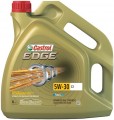Volume
The nominal capacity of the package, in other words, the volume of oil supplied in this packaging option.
Depending on the purpose of the purchase, the type of vehicle and other factors, the optimal volume will be different. So,
liter bottles are useful for replenishing the oil supply, or for tasks that do not require high consumption (for example, infrequent work with a gas tool); a capacity of
4 liters is designed for a complete oil change in a passenger car; the volumes required by trucks can reach tens of liters; and for car parks, service stations and other similar organizations, oil is produced in barrels of about
200 liters.
Compliance
International standards, compliance with which is stated in the characteristics of this brand of oil. In modern brands of oil the following options may be found:
— API is a standard developed in the USA by the American Petroleum Institute. Provides two separate classifications - for gasoline (
API SG,
SH,
SJ,
SL,
SM,
SN,
SN Plus) and for diesel engines (
API CI-4,
CH-4,
CG-4,
CF,
CE,
CD); in the first case, the first letter in the standard designation is S (for example, API SL), in the second it is C (for example, API CI-4). If the oil is suitable for both types of engines, a double designation is used - for example, API SL/CI-4; in this case, the index of the type for which the oil is best suited is put first (in our example, this is gasoline). The standard also includes the classification of two-stroke engines - TA, TB,
TC,
TC+,
TD.
— ACEA is a standard used by the association of European automakers of the same name,
...an alternative to the American API. Includes three classes: A/B - all oils developed before 2004 for different types of engines. Actually, until 2004 there were two classes here - A for gasoline engines and B for diesel engines; then they were combined ( A1/B1, A3/B3, A3/B4 and A5/B5). However, separate designations can still be used. C - oils for all types of engines, meeting the Euro-4 environmental standard and compatible with additional equipment such as catalysts and particulate filters. APEA C1, C2, C3, C4 and C5 occur. E - a separate class for diesel engines of heavy equipment, including special ones. It is marked APEA E4, E6, E7 and E9.
— JASO — developed by the Japanese Auto Standards Association. It is one of the main modern standards for oils for gasoline motorcycle engines, within this purpose it has two classes - F for two-stroke engines, namely FA, FB, FC, FD and M for four-stroke (subclass MA for wet clutch MA-1 and MA -2, MB for dry). As well as a new GLV-1 approval for ultra-efficient gasoline engines and hybrid power plants.
— ILSAC is a standard created jointly by the American and Japanese Automobile Manufacturers Associations. Used for oils designed for passenger cars with gasoline engines. There are only five ILSAC categories ( GF-2, GF-3, GF-4, GF-5, GF-6A), in general they are similar to certain API categories (see above), but differ in increased requirements for energy saving and limitation of harmful emissions .
A list of specific oil standards recommended by the manufacturer for a particular engine is usually indicated in the official vehicle specifications. Note that many standards are interchangeable; compatibility data (as well as a description of each individual category) can be found in specialized sources.Approvals Audi, VW, Skoda, SEAT
An engine oil quality standard that VAG considers essential for correct operation when used in the engine of its vehicles. For various engines (respectively, car brands) there is a standard, among which there are
500.00,
501.01,
502.00,
503.00,
503.01,
504.00,
505.00,
505.01,
506.00,
506.01,
507.00,
508.00, and
508.00 ,Approvals Mercedes-Benz
An engine oil quality standard that Mercedes-Benz considers essential for correct operation when used in the engine of its vehicles. For different engines (respectively, car marks) provides its standard, among which there are
226.5,
226.51,
226.9,
228.5,
229.3,
229.5,
229.5,
229.5, 229.5, 229.5,
229.7,
229.5,
229.5,
229.5,
229.3,
229.5,
229.31 , 229.5Renault approvals
An engine oil quality standard that Renault considers essential for correct operation when used in the engine of its vehicles. For various engines (respectively, car brands) there is a standard, among which are
AN2022,
RN 0700,
RN 0710,
RN 0720,
RD,
RD-2,
RGD,
RLD,
RLD-2,
RLD-3,
RLD-4,
RLS-3,
RVI and
RXD.

